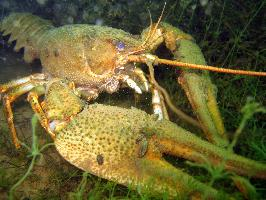
Biological data
| Lifespan | from 15 to 20 years |
|---|
State of endangerment
| Endangered |
Animal description
The European crayfish, scientifically known as Astacus astacus, is a species of freshwater crustacean that belongs to the family Astacidae. It is also commonly referred to as the noble crayfish, broad-fingered crayfish, or simply the crayfish in Europe. This species is native to freshwater habitats across much of Europe, ranging from the Balkans and Italy in the south, extending northward to parts of the British Isles and Scandinavia, and reaching eastwards into parts of Russia.The European crayfish is a keystone species in its ecosystem, playing a crucial role in maintaining the health and balance of freshwater habitats. It is a nocturnal creature, mostly active during the night when it comes out of its hiding to feed, mate, or explore its surroundings.
Morphologically, the European crayfish is characterized by its robust and somewhat elongated body, which can reach lengths of up to 16-18 centimeters in adults, though sizes can vary. Its coloration is typically dark brown to greenish or reddish-brown, providing excellent camouflage against the muddy or rocky freshwater bottoms where it resides. The body of Astacus astacus is divided into two main parts: the cephalothorax, which is the fused head and thorax, and the abdomen. The cephalothorax is covered by a hard protective shell called a carapace, which shields the crayfish from predators and environmental hazards.
One of the most distinctive features of the European crayfish is its pair of large, powerful claws, known as chelae, which are used for defense, communication, and feeding. These claws are capable of grasping, cutting, and crushing food items, which include a wide variety of aquatic plants, detritus, worms, snails, and small fish. The crayfish also has several pairs of walking legs, which it uses for locomotion and handling food.
The life cycle of Astacus astacus is complex and involves several stages. Reproduction typically occurs in the autumn, when males and females engage in a mating ritual. After mating, females carry the fertilized eggs attached to their swimmerets under their tails throughout the winter, with hatching occurring in the spring. The young crayfish, known as juveniles, undergo several molts as they grow, shedding their exoskeleton to allow for growth before reaching maturity.
European crayfish populations have faced significant declines in recent decades, primarily due to habitat loss, pollution, and the introduction of non-native crayfish species, which carry diseases such as crayfish plague (caused by the water mold Aphanomyces astaci). This plague is particularly devastating to native populations, leading to widespread mortality. Conservation efforts are underway in several countries to protect and restore populations of this iconic species, including habitat restoration, captive breeding programs, and measures to control the spread of invasive species.
In addition to its ecological importance, Astacus astacus holds cultural and economic significance in Europe. It is considered a delicacy in many regions, featured in traditional dishes and festive meals. However, due to its declining populations and the resulting conservation measures, fishing for European crayfish is now regulated in many areas to ensure the species' long-term survival.
In summary, the European crayfish, Astacus astacus, is a fascinating and important freshwater crustacean native to Europe, with a rich ecological, cultural, and economic heritage. Despite facing significant challenges, efforts to conserve and protect this species are crucial for maintaining the health and biodiversity of freshwater ecosystems across its native range.
Similar Animals
New photos of animals
Top 10 animals
- Dolphin gull (Leucophaeus scoresbii)
- Diana monkey (Cercopithecus diana)
- Moustached guenon (Cercopithecus cephus)
- Galápagos tortoise (Geochelone nigra complex)
- Japanese macaque (Macaca fuscata)
- Stone loach (Barbatula barbatula)
- Russian tortoise (Testudo horsfieldii)
- Greek tortoise (Testudo graeca)
- Common flying dragon (Draco volans)
- Vendace (Coregonus albula)


